The Wheelchair Guide
Your Wheelchair and Mobility Scooter Resource
Increasing Accessibility With a Power Chair
August 11th, 2009
Today, many of those who use wheelchairs, opt to go with a electric wheelchair. Electric wheelchairs, which are also called power chairs, are popular for a number of reasons, including the fact that they can be operated with very little physical effort on the part of the wheelchair user.
Power chairs are not exactly a new invention and have been used for over fifty years. Back then, however, power chairs were simply manual wheelchairs that had been outfitted with an electric motor. The E & J Manual Wheelchair, which was incredibly popular at the time, actually had several do-it-yourself converter kits, which were sold to consumers, so they could transform their manual wheelchair into an electric wheelchair.
Today, power chairs remain to be very popular, but most do not share the same design as that of a manual wheelchair. Instead, most modern power chairs have a small plastic molded base, which contains the electric motor, axles, batteries, and other electrical components. A chair, often referred to as the captain’s chair, is attached to the base and often looks more like an office chair, complete with armrests, extra padding, headrest, and in some cases a reclining backrest.
Understanding Electric Wheelchair Controls
While the overall design of the power chair has greatly changed since it was first invented over fifty years ago, one thing that is still very similar is the default control system. The standard control system on electric wheelchairs is a joystick control that is attached to one of the chair’s armrest. This allows the power chair to be moved in any direction by the push of a button. However, unlike the original electric wheelchairs, modern wheelchairs also have a throttle setting to control the speed of the wheelchair. They are also much more sensitive than the first wheelchair controls, deftly turning and controlling the wheelchair in a very fluid motion.
While the joystick control system is the default control for most electric wheelchairs, there are many people who are unable to use it. For these people, a number of alternate controls are available, which can allow the power chair to be easily controlled even by people who are unable to move their hands.
Many of the popular alternate wheelchair controls are based around using the head. There are systems that allow the wheelchair to be controlled by head movements and also some that use the individuals breath to move the wheelchair. There are also a great number of experimental wheelchair controls in the works. This includes using magnets on the persons tongue and even several that rely on a brain computer interface, which uses signals from the users brain to control the electric wheelchair.
In addition to alternate control systems that make it easier for the wheelchair user to control their wheelchair, there are also a number of control schemes intended to make it easier for caretakers to move the wheelchair. The most basic is a simple remote control, either wireless or directly attached to the wheelchair, which can be used by someone walking next to the power chair. There are also much more advanced systems, which can learn the floor plans of a home or other area and then be programmed to move the wheelchair to any area in the home.
Electric wheelchairs are very powerful tools and remain to be one of the most popular accessibility tools. While these devices have been around for over fifty years, modern power chairs are much more reliable, durable, and powerful than their predecessors.
Senior Accessibility Tools: Walkers, Wheelchairs and Mobility Scooters
August 7th, 2009
It is often very difficult for seniors to get around and walk for an extended period of time. This restriction can ultimately has a very big impact on their day to day life, as it is necessary to avoid many of the things they enjoy, such as going to the park with the family or walking around the neighborhood. There are three main devices used to address this issue, namely the walker, the mobility scooter, and the wheelchair.
A Brief Look at Walkers
 Walkers have been popular for many years now and come in a number of different styles. Typically, walkers provide system that makes contact with the floor at four different points, to provide increased stability as compared to a cane. Hand holds are provided for both arms and the senior is able to move forward, leaning against the walker for support.
Walkers have been popular for many years now and come in a number of different styles. Typically, walkers provide system that makes contact with the floor at four different points, to provide increased stability as compared to a cane. Hand holds are provided for both arms and the senior is able to move forward, leaning against the walker for support.
Over the past few years, rollators, which are essentially rolling walkers, have become much more popular. Many seniors find rollators much easier to use, because instead of having to lift the walker up with every few steps, they can simply roll it forward. Most rollators also double as a seat and provide a storage basket. There are also hand brakes on the hand holds, which can be locked in place when the senior is not moving.
A Brief Look at Mobility Scooters
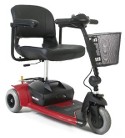 Mobility Scooters are very popular among seniors and provide a motorized way to get around. They have an elongated flat base, with 3 or 4 wheels, and are controlled by a set of handlebars, called a tiller, that extends from the front of the electric scooter. A chair is positioned towards the rear of the mobility scooter.
Mobility Scooters are very popular among seniors and provide a motorized way to get around. They have an elongated flat base, with 3 or 4 wheels, and are controlled by a set of handlebars, called a tiller, that extends from the front of the electric scooter. A chair is positioned towards the rear of the mobility scooter.
Most mobility scooters have a pretty significant range, with some traveling over 15 miles on a single battery charge. Using one allows the senior to get around with ease, traveling over pretty much any type of terrain. However, some are only designed for tightly packed ground.
Electric mobility scooters are powerful aids, used by many seniors and others who have difficulty walking. They can be used both indoors and outdoors, providing an easy and fun way to increase accessibility.
A Brief Look at Wheelchairs
 Wheelchairs are also a popular tool used by seniors who have difficulty walking, however since a wheelchair requires a lot of physical effort to use, they can not always be used independently. Instead, it is usually necessary to rely on someone to push the wheelchair from behind.
Wheelchairs are also a popular tool used by seniors who have difficulty walking, however since a wheelchair requires a lot of physical effort to use, they can not always be used independently. Instead, it is usually necessary to rely on someone to push the wheelchair from behind.
Electric wheelchairs are available as well, but are usually considerably more expensive than mobility scooters. However, unlike mobility scooters, an electric wheelchair can be driven directly up to a table or desk, without having to switch to a chair. So, many people find electric wheelchairs more convenient than mobility scooters.
Modern Power Chairs
August 5th, 2009
 Electric wheelchairs, or power chairs, are today a very important accessibility aid that greatly improves the lives of millions of people every year. While modern power chairs offer similar functionality to the first electric wheelchairs developed almost 60 years ago, their design and reliability has changed a great deal.
Electric wheelchairs, or power chairs, are today a very important accessibility aid that greatly improves the lives of millions of people every year. While modern power chairs offer similar functionality to the first electric wheelchairs developed almost 60 years ago, their design and reliability has changed a great deal.
Power Chair Range and Speed
One of the biggest changes to the modern power chair is that it now uses a much stronger and more reliable electric motor. The batteries are also much improved, offering a much greater per charge distance. This not only means the wheelchair can be driven further faster, but also that it can support more weight and preform better over uneven terrain. It is not uncommon for an electric wheelchair to be able to travel more than 10 miles on a single charge, with a number of power chairs having a range between 15 and 20 miles. The top speed is also significantly higher, with most power chairs traveling at speeds at or above 5 miles per hour.
General Power Chair Design
While from a functionality and reliability standpoint, having an improved electrical system is one of the biggest differences between modern electric wheelchairs and their predecessors, there are also a significant number of changes involving the design of the device. The original electric wheelchairs were simply manual wheelchairs that had been outfitted with an electric motor and battery. However, today, most electric wheelchairs share a much different design.
This includes a much smaller molded plastic base, which contains the electrical components of the wheelchair. A seat is installed upon this plastic base and is usually referred to as the captain’s chair. Depending on the type of wheelchair, the captain’s chair could be relatively small, or it could resemble a high end office chair, with a high back and extended armrests. In either case, it is much different than the chair used on most manual wheelchairs, which is made out of slats of vinyl.
Power Chair Controls
There are in fact a great number of improvements and changes that have been made to the power chair over the years, many of these mechanical, but the standard electric wheelchair control scheme is the same. This is of course the joystick control system, which is found on most electric wheelchairs. The joystick is attached to the armrest of the wheelchairs chair and allows the power chair to be controlled by only the push of a finger.
There are also a number of alternate wheelchair controls that are commonly used, made available for people who are not able to physically able to use a standard joystick control scheme. There are many different types of controls, often aided by computers, allowing power chairs to be controlled by the angle of ones head, an individuals breath, or other parts of their body’s. For caretakers, there are also several popular remote control systems that can be attached to a standard power chair, allowing the unit to be controlled by someone walking behind it.
Even though the modern power chair shares a number of similarities with the first electric wheelchairs in regards to the functionality, they are actually quite different. Not only do they have a completely different design, but the modern power chair is much more reliable and durable.
Manual Wheelchairs vs Electric Wheelchairs
August 3rd, 2009
Wheelchairs are a popular mobility aid that greatly improves the lives of millions of people all over the world. The manual wheelchair has been around for thousands of years, while the electric wheelchair is relatively new, with the first electric wheelchair being developed in the early 1950′s. Choosing between a manual wheelchair or an electric wheelchair is an important decision that should be based upon the needs and requirements of its user.
Consider the Physical Capabilities of the User
One of the most important considerations when choosing between a manual or electric wheelchair is the physical abilities of the wheelchair user. Using a manual wheelchair requires a lot of upper body strength and can be very tiring even for someone who is in perfect health. In addition to having fairly good physical fitness, it is also necessary to use both arms to push a manual wheelchair.
An electric wheelchair, on the other hand, can be controlled by only using a single finger and there are also a number of other alternate controls as well. Alternate wheelchair controls include head controlled wheelchairs and breath controlled wheelchairs. This allows even someone with greatly reduced physical capabilities to use a wheelchair.
Consider Where the Wheelchair Will Be Used
In addition to considering the condition of the wheelchair user, it is also necessary to consider where the wheelchair will be used and how far it will be driven everyday. If the wheelchair is primarily going to be used around the home, then a manual wheelchair might be a good choice, because even though it requires a good deal of physical effort, moving between rooms does not present a very large traveling distance.
If, on the other hand, you intend to use the wheelchair away from home across a larger distance, an electric wheelchair might be a better choice. As an example, traveling across a college campus would be much more strenuous than traveling between rooms in a house. The per charge range of an electric wheelchair varies, but most can travel between 10 and 20 miles without needing to be recharged.
In addition to considering how far one will be traveling in the wheelchair, it is also important to consider what type of terrain will be traveled over. It takes much more effort to move up and down hills than it does to move across straight ground in a manual wheelchair. Some electric wheelchairs are also much better choices for off road use, although it is also possible to buy off road wheels for manual wheelchairs.
Consider the Cost of the Wheelchair
Finally, it is also important to consider the wheelchair users budget, when deciding between a manual wheelchair or an electric wheelchair. There are of course exceptions to the rule on both sides, but typically a manual wheelchair costs significantly less than an electric wheelchair. Usually a quality electric wheelchair costs between $3,500 and $7,000, while a manual wheelchair costs between $300 and $1,500.
When considering cost, it is important to take into account insurance programs, such as Medicare or Medicaid, which will often help to offset the cost of a wheelchair. For example, in the case of Medicare, typically 80% of the cost of the wheelchair is covered, so this can greatly offset the expense of an electric wheelchair.
Incline Platform Lifts and Vertical Platform Lifts
July 29th, 2009
Wheelchair users, both at home and away, usually have trouble with areas that have stairs. Areas with stairs can be very difficult for those using wheelchairs to access. Around the home, this can greatly decrease accessibility, as most homes have a staircase on the front of the home and may also have one inside. To help increase accessibility at home, many people use vertical platform lifts and inclined platform lifts, both of these devices greatly increase accessibility by allowing a wheelchair user full access to their home.
What are Vertical Platform Lifts?
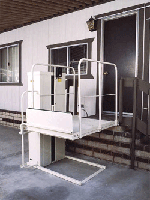 Vertical platform lifts, which are commonly called wheelchair lifts, are most often used on the front steps of a home. The entire unit is basically an elevator, with a strong lifting motor, elevator shaft, and lifting platform all rolled into one single unit.
Vertical platform lifts, which are commonly called wheelchair lifts, are most often used on the front steps of a home. The entire unit is basically an elevator, with a strong lifting motor, elevator shaft, and lifting platform all rolled into one single unit.
A wheelchair lift is placed next to the landing of a staircase. A large metal rectangle or square is provided, which the wheelchair user drives their wheelchair directly onto. The platform then raises vertically to the top of the landing and back down again. Depending on what type of vertical platform lift is used, there are many safety features available. For instance, many include locking doors on the platform, to reduce falls. It is also common for a door to be placed at the top of the landing.
Vertical platform lifts can usually support a minimum of 500 pounds, although this can vary by model, with some supporting more than 700 pounds. Due to their weight capacity, vertical platform lifts can be used by those with manual wheelchairs, electric wheelchairs, and mobility scooters. It is also often possible for multiple people to use the wheelchair lift at once, providing they do not exceed the weight capacity of the device.
While wheelchair lifts work very well on the front of the house, they do not always work on interior staircases. This is because the lift must be placed next to the landing and then raises the user up to the top of the landing. For many interior staircases, this setup just simply does not work.
Inclined Platform Lifts
 To provide interior access to a home with an interior staircase, it is often necessary to use an incline platform lift. Inclined platformed lifts provide a metal track that is attached to the wall of the staircase and runs its entire length. The wheelchair user is carried up the staircase on a platform, which is attached to the metal track.
To provide interior access to a home with an interior staircase, it is often necessary to use an incline platform lift. Inclined platformed lifts provide a metal track that is attached to the wall of the staircase and runs its entire length. The wheelchair user is carried up the staircase on a platform, which is attached to the metal track.
Inclined platform lifts can be used on most types of staircases, including curved ones. However, they do take up a good deal of space on the staircase. This is because the platform that carries the wheelchair user must be large enough for the person and their wheelchair, while also containing guard rails and an electric motor. So, an incline wheelchair lift may not fit on smaller staircases.
Inclined wheelchair lifts can usually be used by those in manual wheelchairs and electric wheelchairs, as well as people using mobility scooters. An incline platform lift operates very similarly to a stair lift, which is used by seniors who have difficulty using the stairs.
Both vertical platform lifts and inclined platform lifts are very popular in commercial settings, such as schools, churches, and office buildings.
Deciding Between Wheelchair Lift or a Wheelchair Ramp
July 27th, 2009
For someone who relies upon a wheelchair or other type of mobility vehicle, using the stairs can be very difficult, if not impossible. As a result, when away from home it is typically necessary to avoid areas with staircases. However, at home this is often not a practical response, as avoiding the staircase might mean you can not get into or out of your own home. To improve accessibility and make it easier to gain access to their home, many wheelchair users choose to install a wheelchair ramp or a vertical platform lift on their front steps.
Wheelchair Ramps
In some instances, choosing to install a wheelchair ramp will be the least expensive option to improve accessibility. Many people custom build a wheelchair ramp out of wood or hire a company to do so, which can be very affordable. It is also possible to buy a modular wheelchair ramp kit, which is made of metal and comes in sections. The height of the staircase dictates how many sections are required and when the ramp arrives, the individual sections are joined together.
When there is only one or two steps that must be overcome, a number of threshold wheelchair ramps are available, which are inexpensive and do not require much installation.
While in some cases a wheelchair ramp is less expensive, in the case of modular wheelchair ramps, there is often little difference in the cost of a vertical platform lift. Wheelchair ramps can also take up a lot of space in the yard, with the amount of space dependent on how high the staircase is. Using a wheelchair ramp is also sometimes difficult for those who use manual wheelchairs.
Wheelchair Lifts
Vertical platform lifts are basically a self contained elevator, which includes an elevator shaft, lifting motor, and lifting platform, all in one unit. Vertical platform lifts, which are often called wheelchair lifts, are installed next to a staircase’s landing and raise vertically between the ground and the landing of the staircase. The user simply maneuvers their wheelchair onto the wheelchair lifts platform and pushes a button, with the wheelchair lift doing the rest.
Most wheelchair lifts have a default lifting height that is around four feet. The device can then usually be upgraded to up to 12 feet, depending on the needs of the user. Most wheelchair lifts support around 500 pounds, with models available that can support over 700 pounds. As long as the lifts weight capacity is not exceeded, multiple people can use the wheelchair lift at once, which can be very useful for caregivers.
Vertical platform lifts require a solid base that is designed to support both the weight of the lift, which is quite heavy, and the weight of the people who will be using the device.
While wheelchair lifts are very easy to use and make using the stairs simple and trouble free, they do typically cost more than a wheelchair ramp, although this is not always the case with modular wheelchair ramps. Most wheelchair ramps cost between $3,500 and $12,000.
Deciding between a wheelchair lift or a wheelchair ramp is an important choice, which should take into account the location where the device is needed, as well as the physical attributes of the person who will be using it.
Vertical Platform Lifts vs Wheelchair Ramps
July 21st, 2009
For those that use wheelchairs, the stairs can present an obstacle that is very difficult to overcome. In some cases, it is possible to simply avoid traveling in areas that have stairs. However, around the home simply avoiding the stairs is typically neither practical or possible. There are several options to help make a homes staircase more accessible, but most people either install a vertical platform lift or a wheelchair ramp. Both of these options have their own advantages and disadvantages, which should be carefully weighed when making a home accessible.
Vertical Platform Lifts
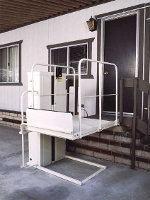 Vertical platform lifts are one of the most efficient ways of allowing a wheelchair user to travel over the stairs. Vertical platform lifts, which are often referred to as wheelchair lifts, are basically like a self contained elevator. The lifting platform, motor, and elevator shaft are all contained in a single unit, which can be placed next to a staircase to improve accessibility. The lifting height varies by model, but most have a default lifting height of around four feet, which can then be upgraded to about twelve feet.
Vertical platform lifts are one of the most efficient ways of allowing a wheelchair user to travel over the stairs. Vertical platform lifts, which are often referred to as wheelchair lifts, are basically like a self contained elevator. The lifting platform, motor, and elevator shaft are all contained in a single unit, which can be placed next to a staircase to improve accessibility. The lifting height varies by model, but most have a default lifting height of around four feet, which can then be upgraded to about twelve feet.
Vertical platform lifts are plugged into a normal electrical outlet and provide a platform for the user to drive their wheelchair onto. Then, the platform can be raised and lowered to allow full access to the home. Some wheelchair lifts include locking gates, both on the lifting platform itself, as well as at the top of the staircase landing to increase safety. Locks are also available, which may be required for commercial wheelchair lifts.
Usually the weight capacity of a vertical platform lift is at least 500 pounds, although some can support more than this. It is possible for more than one person to use the wheelchair lift at once, providing this does not exceed the weight capacity. They can also be used to move boxes or other items up and down the stairs.
Vertical platform lifts require a strong base that can support the weight of the lift, as well as the weight of the people using it. The base can be made from concrete or wood, providing it is sufficient to support the weight and stable.
The cost of a vertical platform lift varies, but usually they cost between $3,500 and $11,000. The installation of a vertical platform lift is straightforward and not very difficult, but the unit itself can be very heavy, so getting it in place may be difficult for some.
Wheelchair Ramps
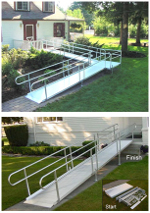 Installing a wheelchair ramp will often be a lower cost alternative to a wheelchair lift. Ramps can be custom made out of wood or metal ramp kits can be bought and assembled. The metal ramp kits typically come in sections, which are assembled at the home, and are referred to as modular wheelchair ramps. The height of the staircase will determine how many sections are needed. In some cases, modular wheelchair ramp kits can prove to be just as expensive as a wheelchair lift.
Installing a wheelchair ramp will often be a lower cost alternative to a wheelchair lift. Ramps can be custom made out of wood or metal ramp kits can be bought and assembled. The metal ramp kits typically come in sections, which are assembled at the home, and are referred to as modular wheelchair ramps. The height of the staircase will determine how many sections are needed. In some cases, modular wheelchair ramp kits can prove to be just as expensive as a wheelchair lift.
Wheelchair ramps offer the advantage of not requiring any electricity to function and since there are no moving parts, there is little about the ramp that can break. However, wheelchair ramps can take up a lot of space in a persons yard and the higher the staircase, the more space they will take up. Using a ramp can also prove to be very strenuous for those who use a manual wheelchair.
When choosing between a wheelchair ramp and a vertical platform lift, it is important to consider the location where the accessibility aid will be installed, as well as the condition of the person who will be using the device. However, for small staircases, which consist of only a step or two, there are a number of threshold ramps available that will be much more practical than a wheelchair lift would be.
The Different Types of Mobility Scooters
July 20th, 2009
For seniors and others who have difficulty walking around, the mobility scooter has been a powerful asset for some time. The first mobility scooters where developed about fifty years ago, but they really did not become practical or popular until the 1980′s.
Today, there are a number of different kinds of mobility scooters available, but they can basically be broken down into three distinct categories: Travel Scooters, Heavy Duty Scooters, and Traditional Scooters. Knowing the difference between these types of mobility scooters is very important, because they each offer their own advantages and disadvantages.
Travel Scooters
 Travel scooters are very popular, because they are lightweight and can be easily disassembled into several easy to manage pieces. Usually, the heaviest piece will weigh less than 30 pounds, so they can be easily picked up and placed in the trunk of a car, stored on a plane, or even placed into the backseat of a vehicle. Many travel scooter are also very easy to take apart and feature clasps that can be operated while only using a single hand. Since these types of scooters can be so easily transported, they can make them a great tool for going to an amusement park or visiting a new city.
Travel scooters are very popular, because they are lightweight and can be easily disassembled into several easy to manage pieces. Usually, the heaviest piece will weigh less than 30 pounds, so they can be easily picked up and placed in the trunk of a car, stored on a plane, or even placed into the backseat of a vehicle. Many travel scooter are also very easy to take apart and feature clasps that can be operated while only using a single hand. Since these types of scooters can be so easily transported, they can make them a great tool for going to an amusement park or visiting a new city.
While travel scooters can be very easy to transport, their lightweight comes at the cost of reduced functionality and stability. They are often not able to support as much weight, nor will a travel scooter fair as well over rougher terrain. Also, travel scooters are basically stripped of all extra features, to help reduce weight, including having a reduced per-charge range.
Travel Scooters Typically Cost: $800 – $1500
Heavy Duty Scooters
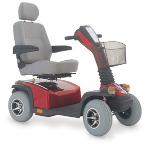 Heavy Duty Scooters are pretty much the exact opposite of travel scooters. A heavy duty scooter offers superior weight capacity and off road maneuverability. They feature reinforced frames and often include special bumpers for added protection. Larger off-road tires and improved ground clearance make heavy duty scooters able to be driven pretty much anywhere. These mobility vehicles also include a number of other features designed to improve comfort and usability, such as overstuffed captains chairs and upgraded suspension.
Heavy Duty Scooters are pretty much the exact opposite of travel scooters. A heavy duty scooter offers superior weight capacity and off road maneuverability. They feature reinforced frames and often include special bumpers for added protection. Larger off-road tires and improved ground clearance make heavy duty scooters able to be driven pretty much anywhere. These mobility vehicles also include a number of other features designed to improve comfort and usability, such as overstuffed captains chairs and upgraded suspension.
While heavy duty scooters are an excellent tool for those who need a higher weight capacity or want a scooter that can be driven off-road with confidence, they are fairly large in size. They also have a larger turning radius, so when combined with their large size, heavy duty mobility scooters might take up too much space to be used effectively inside of a home. Also, due to their size, a vehicle scooter carrier is required to transport them. Like other types of mobility scooters, a heavy duty scooter can be disassembled, however the individual pieces are much heavier, sometimes weighing over 100 pounds. It is also not as easy to disassemble as a travel scooter would be.
Heavy Duty Scooters Usually Cost: $1500 – $5000
Traditional Scooters
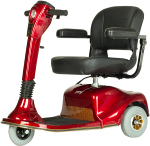 Traditional scooters fall in between heavy duty scooters and travel scooters. They preform well inside of a home and can also be used over most outdoor surfaces, providing the surface is fairly well packed. They include a number of features, such as running lights, and typically have a per-charge range of around 8 – 10 miles. Traditional scooters provide a great deal more stability than a travel scooter and typically support more weight as well.
Traditional scooters fall in between heavy duty scooters and travel scooters. They preform well inside of a home and can also be used over most outdoor surfaces, providing the surface is fairly well packed. They include a number of features, such as running lights, and typically have a per-charge range of around 8 – 10 miles. Traditional scooters provide a great deal more stability than a travel scooter and typically support more weight as well.
While traditional scooters are very sturdy, they are not as well suited for rougher outdoor terrain or wet ground. These types of scooters can be taken apart as well, but the individual pieces are not as lightweight as a travel scooter, nor is a traditional scooter as easy to take apart. In most cases, a vehicle scooter carrier is required to transport these devices, as they take up much more space and are a good deal heavier than travel scooters.
Traditional Scooters Typically Cost: $1300 – $2500
Electric Wheelchairs of Today and Yesterday
July 19th, 2009
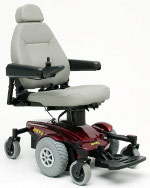 Today, electric wheelchairs are essential mobility vehicles, used by millions of people all over the world. Electric wheelchairs have changed a great deal over the last fifty years and remain incredibly popular, especially among those who are unable to use a manual wheelchair.
Today, electric wheelchairs are essential mobility vehicles, used by millions of people all over the world. Electric wheelchairs have changed a great deal over the last fifty years and remain incredibly popular, especially among those who are unable to use a manual wheelchair.
When electric wheelchairs, or power chairs, were first invented, an electric motor was placed onto a manual wheelchair, allowing it to be controlled electronically. This was a major improvement, which greatly increased the accessibility of those who were otherwise unable to get around by themselves. A number of companies quickly formed to sell these manual wheelchair converter kits, which were usually based off of the E & J Wheelchair.
While it is still possible to buy manual wheelchair converter kits, most electric wheelchairs today consist of a molded plastic base, which contains the electronic components of the wheelchair, with a large comfortable chair fitted onto the base. As a result, most modern electric wheelchairs can not be reverted into a manual wheelchair should the battery die, but they are much more powerful and often include a lot of neat features.
Most electric wheelchairs are controlled by using a simple joystick, which is secured to the arm of the chair. The joystick can be configured for left hand or right hand use, which is typically done by the manufacturer, although it is typically possible for the user to change this as well. In addition to the joystick, a simple throttle, which controls the speed of the wheelchair, is also usually on the arm of the chair. For those who are not able to use the standard wheelchair control, alternative controls are also available.
Many of todays electric wheelchairs share a number of similarities, both in the way they are designed, as well as the way they look. Typically, electric wheelchairs are classified by the type of drive system, either mid-wheel drive or rear wheel drive, as well as by how easy it is to transport the wheelchair.
In a mid-wheel drive electric wheelchair, the base of the wheelchair will typically have three rows of wheels. The middle row is the row that is responsible for moving and turning the wheelchair, while the other two rows help provide support. A mid-wheel drive system is extremely maneuverable, which makes it great for indoor use. In a rear wheel drive wheelchair, there will usually only be two rows of wheels, with the rear wheels being responsible for moving and turning. While not quite as maneuverable as a mid-wheel drive wheelchair, a rear wheel drive wheelchair does provide a little bit more stability because the weight is more evenly distributed between the base of the chair.
The other way that power chairs are classified is by how easy it is to transport them. Travel wheelchairs are available, which are designed to be taken apart to make it easier for them to be transported in a vehicle. There are even some folding electric wheelchairs, which closely resemble the design of a manual wheelchair. If you do not have a travel wheelchair, you will likely need a wheelchair lift to transport the device in a vehicle. This is because even though most electric wheelchairs can be disassembled, the individual pieces of a non-travel wheelchair can be very heavy.
The electric wheelchair has come a long way over the last fifty years and is today a very important tool for millions of people all across the World.
Prescribing a Wheelchair: Follow Up Care
July 13th, 2009
 When a doctor prescribes a wheelchair to a user, it is very important that the wheelchair fits the needs of the user. It is also very important that the wheelchair user have a great deal of input over the process, because not only must their physical needs be met, but there are a number of other considerations, like where the person intends to primarily use their wheelchair, that should be considered.
When a doctor prescribes a wheelchair to a user, it is very important that the wheelchair fits the needs of the user. It is also very important that the wheelchair user have a great deal of input over the process, because not only must their physical needs be met, but there are a number of other considerations, like where the person intends to primarily use their wheelchair, that should be considered.
It is encouraged that new wheelchair users also talk with experienced wheelchair users and do a good deal of research on their own, because often doctors, while very well meaning, are not very experienced with wheelchairs and have never actually used one for an extended period of time. Due to health and safety concerns, it is very important that the wheelchair fits the physical requirements of the user.
Once the wheelchair arrives, everything should be remeasured and the wheelchair fully evaluated to ensure that it does in fact fit the needs of the user, however the doctors responsibility does not stop here. Instead, the wheelchair and its effect on the user should be reevaluated with each visit to the doctor.
One of the most important things that a doctor should look for is how the wheelchair is affecting the posture of its user. This is often something that can not be seen until after the user has been using the wheelchair for some time. Proper posture is essential for wheelchair users, because overtime a poor sitting position can cause a great number of health problems.
The actual condition of the wheelchair should also be checked and the user should be trained in how to properly maintain and care for their wheelchair. This includes lubricating moving parts, removing and cleaning the components, adjusting the anti-tip casters, and regularly checking the wheelchairs bolts for tightness. Emergency maintenance, such as how to fix a flat tire, should also be shown.
It is also very important that the wheelchair user be trained in how to navigate environmental factors that they might encounter. This includes the ability to move over curbs, navigate steps, and traveling on hills. Proper transfer techniques should also be shown and the user should be trained on how to fall out of the chair and recover. There are several places across the country that offer a sort of wheelchair obstacle course, to help train new wheelchair users and experienced wheelchair users alike.
The doctor should also make sure that the users home area is wheelchair friendly. It may be necessary to widen doors, install ramps, or a wheelchair lift. The doctor should talk with the patient and explain some of the options available.